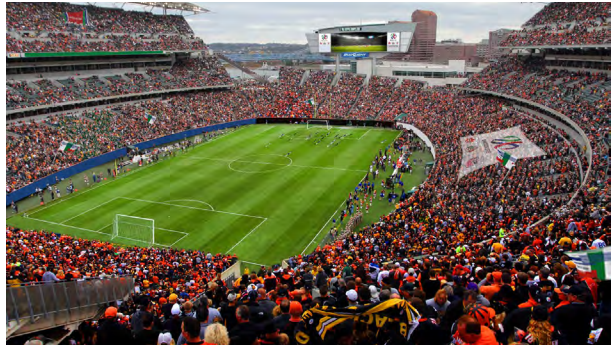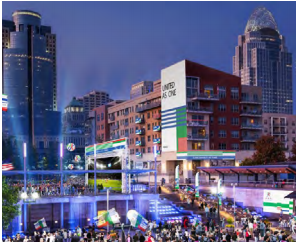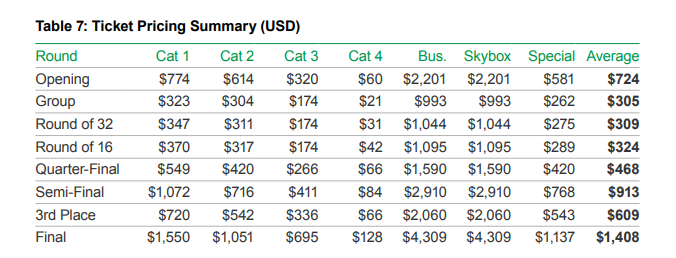
On Monday, FIFA (Fédération Internationale de Football Association) released the bid packages from the United Bid (United States, Canada and Mexico) and Morocco for the 2026 Men’s World Cup. The United Bid’s document presented facts and figures on the 23 bid candidate cities for the tournament. If the bid is award to the United group, the governing bodies will select 16 cities to host matches with other cities to act as “fan fests” and “base camps”. This was our first glimpse into the details of Cincinnati’s host city proposal. Our staff reviewed the document and noticed several intriguing specific about the bid and possible MLS (Major League Soccer) future.

Each city was asked to provide a vision for their event. Cincinnati’s vision is based on the city’s renaissance. The re-birth of the riverfront, downtown, and Over-the-Rhine neighborhoods are a result of non-profits, for-profits, and community, business and city leaders, coming together to advance and grow the Queen City. This revitalization has been epitomized by the birth and explosion of FC Cincinnati on both the national and international football stages.
Carl Lindner III has been listed as the Cincinnati bid’s chairperson with FC Cincinnati President and GM Jeff Berding listed as the Deputy Chairperson. One would think that having the CEO of American Financial Group and one of the city’s largest philanthropists could be a selling point for the bid. The Queen City was listed as bidding for matches up to the quarterfinals and the third place match of the competition. Forty-eight teams and 80 games will comprise the 2026 event representing the largest field in tournament history.
The bid highlights Cincinnati’s rich sporting heritage including the growth of FC Cincinnati. Cincinnati also boasts of having a large youth soccer structure with over 60,000 kids playing in the area. Games would be hosted in Paul Brown Stadium, which would have an approximate capacity of 67,402 for the Men’s World Cup. PBS is the second smallest US stadium (Orlando – 65,000) included in the bid.

As part of the bid package, Cincinnati was required to provide practice sites, lodging and other amenities relevant to the bid. UC’s Gettler Stadium, the NKU Soccer Stadium, the Xavier University Soccer Complex, and the Mount St. Joseph Sports Complex were all listed as training sites. The future FC Cincinnati MLS stadium, UC’s Nippert Stadium and the future FC Cincinnati Training Ground were all listed as potential “team base” sites for the tournament. The bid did list the future training ground as having at least four regulation-sized pitches, be accompanied with state-of-the-art team training facilities, and would be located in Milford. The site has not been officially agreed upon according to sources with Clermont County, Hamilton County, and Northern Kentucky all bidding on the site.
All bid cities were required to list accommodations for visiting fans and teams. Cincinnati ranked 13th on this list with a total amount of hotel rooms available at 23,625 for the event. The only issue Cincinnati may have in this category is the amount of premium four- or five-star hotel rooms. FIFA would require almost 80 percent of all five-star rooms and nearly 30 percent of all four-star room availability during the tournament. The Cincinnatian was listed as the FIFA VIP Hotel while the Hilton Netherland Plaza was listed as the FIFA Venue Hotel.
The bid package goes into detailing mass transit including mentioning Cincinnati’s bus lines, streetcar, highways and the red bike as ways for fans to commute around the city. CVG (one-hour flight from 60 percent of U.S. population) and the city’s Amtrak terminal were also mentioned as avenues for fans to travel to the area. Cincinnati did have one glaring weakness in this category. Only Kansas City, Miami, and Nashville were the other U.S. cities without a rail system from the airport into downtown. Cincinnati will have to address this in a big way outside of celebrating the airport’s new rental car terminal.

Bid cities are also required to have fan interaction areas for the tournament. Cincinnati provided two venues for “fan fests” listing Sawyer Point/Yeatman’s Cove and the Banks to host these events. The Sawyer Point fest could host up to 250,000 people at the riverfront parks while the Banks was listed as hosting up to 35,000. Cincinnati should at worst host these large events for the tournament. FIFA has many sponsors that would want to get in front of the public.
Towards the end of the 580-page document, the organizing group listed ticket revenue projections. The 2026 projection is forecasted to have at least $1.8 billion in ticket revenue with the average price of a ticket for a match in Cincinnati coming in around $300-$450. There are varying levels of ticket pricing for the events, but these numbers would seem to fit in terms of other high profile events in North America. Certainly not a cheap ticket.

Thoughts:
After reviewing the document, I have to think that Cincinnati’s chances to host a match in the 2026 Men’s World Cup will be small. Do I think we fit in a great spot geographically? Yes, but we are also a close enough drive to Nashville. I also realize that could work the other way with a large part of the Midwest vacant outside of Kansas City. The United Bid must eliminate seven cities by 2020 if some don’t eliminate themselves due to the immense cost of the event. I think it is possible to say the organizing committee will most likely eliminate one city from Canada and Mexico, two of the Northeastern cities (Boston, DC, Philadelphia, Baltimore or New York/N.J.), leaving three cities to get to the magical number of 16.
Cincinnati seems to check off many boxes for the bid, including hotel rooms, facilities, location, but fails in lacking quality transportation around town. Being close to a large part of the population (60 percent) is a plus, but can the airport, Amtrak and other transportation avenues handle the influx of people over the span of several weeks?
Also, will the local government provide the funds necessary to host the event? Communities are on the hook for security needs, infrastructure improvements and more. Given the fact that our region has many big-ticket items coming up soon (Brent Spence Bridge or Western Hills Viaduct), will it spend to put the city in the international spotlight?
I think hosting the Men’s World Cup would be a huge win for our city, and I think our Cincinnati hospitality would be amazing with the international community. Our city is experiencing a renaissance, and this could continue it well into the next decade. I encourage our leaders to spend on this big-ticket item because I believe it will the returns will be priceless for our city. Who knew of Curitiba, Manaus, or Fortaleza before the World Cup? (Sorry, not a world traveler here.)
Thank you to Jeff Berding and Carl Lindner III for getting our city to this point in the process. I would really love to see more city leaders pick up the banner and carry it into the future.
@bryanweigel of @CincySoccerTalk













